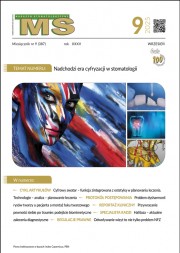Dostęp do tego artykułu jest płatny.
Zapraszamy do zakupu!
Po dokonaniu zakupu artykuł w postaci pliku PDF prześlemy bezpośrednio pod twój adres e-mail.
PIŚMIENNICTWO
1. Kokten G., Balcioglu H., Buyukertan M.: Supernumerary fourth and fifth molars: A report of two cases. J. Contemp. Dent. Pract., 2003, 4, 67-76.
2. Brook A.H.: Dental anomalies of number, form and size: their prevalence in British schoolchildren. J. Int. Assoc. Dent. Child., 1974, 5, 37-53.
3. Rahnama M. i wsp.: Dysplazja obojczykowo-czaszkowa z mnogim zatrzymaniem zębów. Mag. Stomatol., 2012, XXII, 7-8, 70-72.
4. Luten J.R. Jr.: The prevalence of supernumerary teeth in primary and mixed dentitions. J. Dent. Child., 1967, 34, 346-353.
5. Peterson L.J. i wsp.: Principles of Management of Impacted Teeth. Contemporary Oral and Maxillofacial Surgery. Mosby, St. Louis (Mo) 1993, 223-257.
6. Nik-Hussein N.N.: Supernumerary teeth in the premaxillary region: its effects on the eruption and occlusion of the permanent incisors. Aust. Orthod. J., 1990, 11, 247-250.
7. Garvey M.T., Barry H.J., Blake M.: Supernumerary teeth – an overview of classification, diagnosis and management. J. Can. Dent. Assoc., 1999, 65, 612-616.
8. Högström A., Andersson L.: Complications related to surgical removal of anterior supernumerary teeth in children. ASDC J. Dent. Child., 1987, 54, 341-343.
9. Solares R.: The complications of late diagnosis of anterior supernumerary teeth: case report. ASDC J. Dent. Child., 1990, 57, 209-211.
10. Ajith S.D. i wsp.: Management of multiple impacted teeth: a case report and review. J. Int. Oral Health, 2014, 6, 93-97.
11. Smailiene D., Sidlauskas A., Bucinskiene J.: Impaction of the central maxillary incisor associated with supernumerary teeth – initial position and spontaneous eruption timing. Stomatologija, 2006, 8, 103-107.
12. Alling C.A., Hellric J.F., Alling R.: Impacted teeth. W.B. Saunders Company, Philadelphia 1993, 46-49.
13. Di Biase D.D.: The effects of variations in tooth morphology and position on eruption. Dent. Pract. Dent. Rec., 1971, 22, 95-108.
14. Jafri S.A.H. i wsp.: Management of an inverted impacted mesiodens, associated with a partially erupted supplemental tooth – a case report. Ind. J. Dent., 2011, 2, 40-43.
15. Mitchell L., Bennett T.G.: Supernumerary teeth causing delayed eruption – a retrospective study. Br. J. Orthod., 1992, 19, 41-46.
16. Yun-Hoa J., Ji-Yeon K., Bong-Hae C.: The effects of impacted premaxillary supernumerary teeth on permanent incisors. Imaging Sci. Dent., 2016, 46, 4, 251-258.
17. Vermette M.E., Kokich V.G., Kennedy D.B.: Uncovering labially impacted teeth: apically positioned flap and closed-eruption techniques. Angle Orthod., 1995, 65, 23-32.
18. Cercadillo-Ibarguren I. i wsp.: Periodontal health and esthetic results in impacted teeth exposed by apically positioned flap technique. Med. Oral. Patol. Oral. Cir. Bucal., 2011, 16, 89-95.
19. Hunter S.: Treatment of the unerupted maxillary canine. Br. Dent. J., 1983, 154, 294-296.
20. Magnusson H.: Saving impacted teeth. J. Clin. Orthod., 1990, 24, 246-249.
21. Spuntarelli M. i wsp.: Combined orthodontic-surgical approach in the treatment of impacted maxillary canines: Three clinical cases. Oral Implantol. (Rome), 2015, 8, 63-67.
22. Pavlidis D., Daratsianos N., Jäger A.: Treatment of an impacted dilacerated maxillary central incisor. Am. J. Orthod. Dentofacial Orthop., 2011, 139, 378-387.














